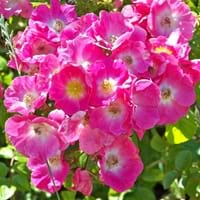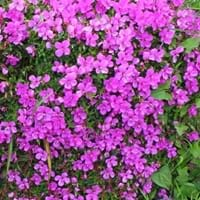Life Span
Annual and Perennial
Perennial
Type
Perennial
Tender Perennial
Origin
Hybrid origin
Mexico, Central America
Types
it is a type of rose
Not Available
Habitat
Not Available
agricultural areas, Loamy soils, Warmer regions
USDA Hardiness Zone
5-8
10-15
Sunset Zone
A1, A2, A3, H1, H2, 1a, 1b, 2a, 2b, 3a, 3b, 4, 5, 6, 7, 8, 9, 10, 11, 12, 13, 14, 15, 16, 17, 18, 19, 20, 21, 22, 23, 24
H1, H2, 22, 23, 24
Habit
Vining/Climbing
Spreading
Minimum Width
Not Available
Flower Color
White, Pink
Fuchsia
Flower Color Modifier
Not Available
Bicolor
Fruit Color
Non Fruiting Plant
Not Available
Leaf Color in Spring
Dark Green
Dark Green
Leaf Color in Summer
Dark Green
Dark Green
Leaf Color in Fall
Dark Green
Dark Green
Leaf Color in Winter
Light Green
Light Green
Leaf Shape
Oval
Oval Cordate
Plant Season
Summer
Spring, Summer, Fall, Winter
Sunlight
Full Sun, Partial Sun
Partial shade
Type of Soil
Loam, Sand
Loam
The pH of Soil
Acidic, Neutral
Acidic, Neutral
Soil Drainage
Well drained
Well drained
Bloom Time
Summer, Late Summer
Indeterminate
Tolerances
Drought
Dry Conditions, Soil Compaction, Sun
Where to Plant?
Container, Ground, Pot
Container, Ground
How to Plant?
Divison, Seedlings
Seedlings, Stem Cutting
Plant Maintenance
Medium
Medium
Watering Requirements
Water Deeply, Water in morning to avoid prompting diseases
Do not let dry out between waterings, Do not water the foliage
In Summer
Lots of watering
Lots of watering
In Spring
Moderate
Moderate
In Winter
Average Water
Average Water
Soil pH
Acidic, Neutral
Acidic, Neutral
Soil Type
Loam, Sand
Loam
Soil Drainage Capacity
Well drained
Well drained
Sun Exposure
Full Sun, Partial Sun
Partial shade
Pruning
Prune after flowering, Remove damaged leaves, Remove dead branches
A hard prune may be necessary if the plant becomes woody, Cut upper 1/3 section when young to enhancegrowth
Fertilizers
Fast release fertilizer, Fertilize in early spring, Fertilize three times a year
Fertilize every three months
Pests and Diseases
Aphids, Black Spot, Caterpillars, Downy mildew, glasshouse red spider mite, Insects, Leaf Hoppers, Powdery mildew, rose leaf-rolling sawfly, Rust, Scale
Bacteria, Birds, Fungal Diseases, Red blotch
Plant Tolerance
Drought
Dry Conditions, Full Sun, Salt and Soil Compaction
Flower Petal Number
Single
Single
Foliage Texture
Medium
Fine
Foliage Sheen
Glossy
Glossy
Attracts
Not Available
Beetles, Bugs, Insects
Allergy
Not Available
Acidic, allergic conjunctivitis
Aesthetic Uses
Showy Purposes, Used for decorating walls, fences, gates, hedges, etc.
Beautification, Hanging Basket, Landscape Designing
Beauty Benefits
Perfumes
Makes Hair Silkier, Making cosmetics
Environmental Uses
Air purification
Forms dense stands, Provides ground cover, soil stabilisation
Medicinal Uses
No Medicinal Use
Not Available
Part of Plant Used
Flowers, Whole plant
Leaves, Stem
Other Uses
Used as Ornamental plant
Air freshner, Cosmetics, Showy Purposes
Used As Indoor Plant
Yes
Sometimes
Used As Outdoor Plant
Yes
Yes
Garden Design
Cutflower, Feature Plant, Groundcover, Hedges, Mixed Border, Rock Garden / Wall, Topiary / Bonsai / Espalier, Vine
Bedding Plant, Container, Groundcover, Hanging Basket, Mixed Border, Tropical
Botanical Name
ROSA 'American Pillar'
HETEROCENTRON elegans
Common Name
Climbing Rose, Rambling Rose
Spanish Shawl
In Hindi
Climbing Rose
Heterocentron
In German
Kletterrose
Heterocentron
In French
escalade Rose
Heterocentron
In Spanish
Rose que sube
Heterocentron
In Greek
αναρρίχηση Rose
Heterocentron
In Portuguese
Rosa de escalada
Heterocentron
In Polish
Climbing Rose
Heterocentron
In Latin
Rosa scandere
Heterocentron
Phylum
Magnoliophyta
Magnoliophyta
Class
Magnoliopsida
Magnoliopsida
Family
Rosaceae
Melastomataceae
Clade
Not Available
Angiosperms, Monocots
Tribe
Not Available
Abreae
Subfamily
Not Available
Not Available
Number of Species
Not Available
Not Available
Season and Care of Climbing Rose and Spanish Shawl
Season and care of Climbing Rose and Spanish Shawl is important to know. While considering everything about Climbing Rose and Spanish Shawl Care, growing season is an essential factor. Climbing Rose season is Summer and Spanish Shawl season is Summer. The type of soil for Climbing Rose is Loam, Sand and for Spanish Shawl is Loam while the PH of soil for Climbing Rose is Acidic, Neutral and for Spanish Shawl is Acidic, Neutral.
Climbing Rose and Spanish Shawl Physical Information
Climbing Rose and Spanish Shawl physical information is very important for comparison. Climbing Rose height is 300.00 cm and width Not Available whereas Spanish Shawl height is 30.00 cm and width 60.00 cm. The color specification of Climbing Rose and Spanish Shawl are as follows:
Climbing Rose flower color: White and Pink
Climbing Rose leaf color: Dark Green
Spanish Shawl flower color: Fuchsia
- Spanish Shawl leaf color: Dark Green
Care of Climbing Rose and Spanish Shawl
Care of Climbing Rose and Spanish Shawl include pruning, fertilizers, watering etc. Climbing Rose pruning is done Prune after flowering, Remove damaged leaves and Remove dead branches and Spanish Shawl pruning is done A hard prune may be necessary if the plant becomes woody and Cut upper 1/3 section when young to enhancegrowth. In summer Climbing Rose needs Lots of watering and in winter, it needs Average Water. Whereas, in summer Spanish Shawl needs Lots of watering and in winter, it needs Average Water.





